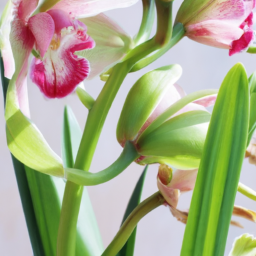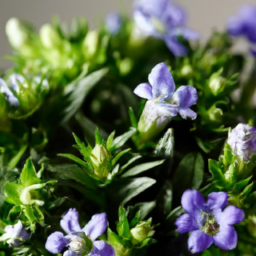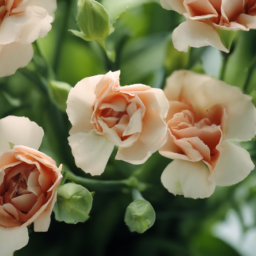
Are you looking to add some greenery and color to your home but don’t have the greenest thumb? Fear not, because today we’re going to talk about the easiest flowers to keep alive. Whether you’re a beginner gardener or just looking for low-maintenance plants, these flowers are perfect for adding a touch of nature to your space without all the fuss. Let’s dive in and discover some of the best options for those of us who struggle to keep plants alive!
Top 5 Easiest Flowers to Keep Alive
Choosing the Right Flowers
When it comes to choosing the easiest flowers to keep alive, there are a few key factors to consider. First and foremost, you’ll want to select flowers that are known for their resilience and ability to thrive in a variety of conditions. Some of the top choices for beginner gardeners include marigolds, petunias, zinnias, impatiens, and pansies.
Marigolds are a popular choice for their bright colors and ability to repel pests. They are low-maintenance flowers that can thrive in both sunny and partially shaded areas. Petunias are another great option for beginners, as they are known for their long blooming period and vibrant hues. Zinnias are easy to grow from seed and come in a wide range of colors, making them a versatile choice for any garden.
Impatiens are shade-loving flowers that are perfect for adding a pop of color to areas with limited sunlight. They are also known for their ability to attract pollinators such as butterflies and hummingbirds. Pansies are cold-tolerant flowers that can withstand fluctuating temperatures, making them an ideal choice for early spring and fall planting.
Caring for Your Flowers
Once you’ve selected the right flowers for your garden, it’s important to provide them with the proper care to ensure they thrive. One of the most important factors to consider is watering. Most flowering plants prefer consistently moist soil, so be sure to water them regularly, especially during hot, dry weather.
In addition to watering, it’s important to provide your flowers with the proper nutrients. Consider using a balanced fertilizer to promote healthy growth and blooming. You may also want to deadhead your flowers regularly to encourage new growth and prolong the blooming period.
Another key aspect of caring for your flowers is ensuring they receive adequate sunlight. Most flowering plants prefer full sun, which typically means at least six hours of direct sunlight per day. If you’re growing flowers that prefer shade, be sure to place them in a location that receives filtered sunlight or dappled shade.
Troubleshooting Common Issues
Even the easiest flowers to keep alive can run into problems from time to time. One common issue that many gardeners face is pests. Keep an eye out for signs of insect damage, such as holes in leaves or chewed flowers. If you notice any pests, consider using natural remedies such as neem oil or insecticidal soap to control the infestation.
Another common issue that can affect flowering plants is disease. Signs of disease include yellowing leaves, moldy growth, or stunted growth. To prevent disease, be sure to plant your flowers in well-draining soil and avoid overcrowding them. If you do encounter disease, consider removing and disposing of affected plants to prevent it from spreading.
By choosing the right flowers, providing them with proper care, and addressing any issues that arise, you can enjoy a beautiful and thriving garden full of easy-to-care-for flowers. With a little bit of time and effort, you can create a colorful and vibrant outdoor space that will bring you joy for years to come.

Tips for Caring for Low-Maintenance Flowers
Choosing the Right Low-Maintenance Flowers
When it comes to choosing low-maintenance flowers, there are a few key factors to consider. First and foremost, you’ll want to select flowers that are well-suited to your climate and growing conditions. Some flowers thrive in hot, dry climates, while others prefer cooler, more humid environments. Be sure to do your research and choose flowers that are well-suited to your specific location.
In addition to considering your climate, you’ll also want to think about the amount of sunlight your flowers will receive. Some low-maintenance flowers do best in full sun, while others prefer partial shade. Be sure to take note of the sunlight conditions in your garden or outdoor space before selecting your flowers.
Finally, consider the soil conditions in your garden. Some low-maintenance flowers are more tolerant of poor soil quality, while others require well-draining, nutrient-rich soil. Be sure to choose flowers that are well-suited to the soil conditions in your garden to ensure they thrive with minimal care.
Planting and Watering Low-Maintenance Flowers
Once you’ve selected the right low-maintenance flowers for your garden, it’s time to plant them. When planting your flowers, be sure to follow the instructions on the plant tag or seed packet. Most low-maintenance flowers prefer to be planted in well-draining soil, so be sure to amend your soil if necessary.
When it comes to watering your low-maintenance flowers, less is often more. Many low-maintenance flowers are drought-tolerant and prefer to be watered infrequently. Be sure to water your flowers deeply, allowing the water to penetrate the soil and reach the roots. Avoid frequent, shallow watering, as this can lead to shallow root systems and weak plants.
In addition to watering, be sure to mulch around your low-maintenance flowers to help retain moisture in the soil. Mulch also helps to suppress weeds and regulate soil temperature, creating a more hospitable environment for your flowers to thrive.
Pruning and Fertilizing Low-Maintenance Flowers
While low-maintenance flowers require minimal care, they will still benefit from occasional pruning and fertilizing. Deadheading spent blooms will encourage your flowers to produce more blooms, prolonging the flowering season. Be sure to use clean, sharp pruners to avoid damaging the plant.
When it comes to fertilizing your low-maintenance flowers, less is often more. Many low-maintenance flowers do not require frequent fertilization and can thrive with minimal nutrients. Be sure to use a balanced, slow-release fertilizer to avoid overfeeding your plants.
In addition to pruning and fertilizing, be sure to keep an eye out for pests and diseases that may affect your low-maintenance flowers. Regularly inspect your plants for signs of pests or disease, and take action promptly to prevent further damage.
By following these tips for caring for low-maintenance flowers, you can enjoy a beautiful, thriving garden with minimal effort. Choose the right flowers for your climate and growing conditions, plant them properly, water them infrequently, and provide occasional pruning and fertilizing as needed. With a little care and attention, your low-maintenance flowers will reward you with vibrant blooms and lush foliage year after year.

Best Flowers for Beginners: Simple Care Instructions
Choosing the Right Flowers
When it comes to choosing the best flowers for beginners, it’s important to consider a few key factors. First and foremost, you’ll want to select flowers that are known for their hardiness and resilience. Some great options for beginners include marigolds, petunias, and zinnias. These flowers are relatively easy to care for and can withstand a variety of growing conditions.
In addition to hardiness, you’ll also want to consider the amount of sunlight and water your chosen flowers will need. Some flowers, like geraniums and impatiens, prefer partial shade and regular watering, while others, like sunflowers and daisies, thrive in full sun and require less frequent watering. Make sure to research the specific care requirements of each flower before making your selection.
Lastly, consider the climate in which you live. Some flowers are better suited to certain climates than others, so it’s important to choose flowers that will thrive in your specific environment. For example, if you live in a hot, dry climate, you may want to opt for drought-tolerant flowers like succulents or lavender.
Caring for Your Flowers
Once you’ve selected the perfect flowers for your garden, it’s important to provide them with the proper care to ensure they thrive. One of the most important factors in caring for your flowers is watering. Most flowers prefer to be watered deeply but infrequently, allowing the soil to dry out between waterings. Overwatering can lead to root rot, so be sure to monitor the moisture levels in your soil regularly.
In addition to watering, it’s important to provide your flowers with the proper amount of sunlight. Most flowers require at least 6-8 hours of sunlight per day to thrive, so be sure to plant them in a location where they will receive adequate sunlight. If you’re growing flowers indoors, consider placing them near a sunny window or using a grow light to supplement natural sunlight.
Finally, don’t forget to fertilize your flowers regularly to promote healthy growth and blooming. Choose a fertilizer that is specifically formulated for flowering plants and follow the instructions on the packaging for best results. Over-fertilizing can actually harm your flowers, so be sure to use the recommended amount and frequency.
Troubleshooting Common Issues
Even the best gardeners encounter problems from time to time, so it’s important to be prepared to troubleshoot common issues that may arise with your flowers. One common problem is pests, such as aphids or spider mites, which can damage your flowers if left unchecked. Keep an eye out for signs of pests, like yellowing leaves or sticky residue, and treat the problem promptly with insecticidal soap or neem oil.
Another common issue is disease, which can manifest as wilting, yellowing, or spotted leaves. To prevent disease, make sure to plant your flowers in well-draining soil and avoid overcrowding them, which can promote the spread of disease. If you notice signs of disease, remove affected leaves or flowers and treat the remaining plant with a fungicide as needed.
By following these simple care instructions and being prepared to troubleshoot common issues, you can enjoy beautiful, thriving flowers in your garden with minimal effort. Remember to choose hardy, resilient flowers that are well-suited to your growing conditions, provide them with the proper care, and address any problems promptly to ensure their continued success.
I’ll leave you with these final thoughts
Are you tired of buying beautiful flowers only to have them wilt and die within a few days? If so, you’re not alone. Keeping flowers alive can be a challenge, especially for those of us without a green thumb. But fear not, there are some flowers out there that are incredibly easy to care for and will brighten up your home for weeks on end.
One of the easiest flowers to keep alive is the peace lily. This elegant plant thrives in low light and only needs to be watered once a week. Another great option is the spider plant, which is virtually indestructible and can survive in a variety of conditions. For those looking for a pop of color, consider getting a geranium. These vibrant flowers are low-maintenance and will bloom all summer long with minimal care. So if you’re looking to add some greenery to your home without the stress of constant upkeep, consider these easy-to-care-for flowers.
Frequently Asked Questions (FAQ):
Q1: What are some of the easiest flowers to keep alive?
A1: Some of the easiest flowers to keep alive include marigolds, petunias, zinnias, and sunflowers. These flowers are known for their low maintenance requirements and resilience to various weather conditions.
Q2: How often do I need to water these easy-to-care-for flowers?
A2: The frequency of watering will depend on the specific flower and the climate in which you live. Generally, it’s best to water these flowers when the top inch of soil feels dry to the touch. Overwatering can be just as harmful as underwatering, so it’s important to find the right balance.
Q3: Do these flowers require a lot of sunlight?
A3: Most easy-to-care-for flowers thrive in full sunlight, but some can also tolerate partial shade. It’s best to check the specific sunlight requirements for each type of flower you choose to ensure they receive the appropriate amount of light.
Q4: What type of soil is best for these low-maintenance flowers?
A4: Well-draining soil is key for these easy-to-care-for flowers. A good quality potting mix specifically designed for flowers is usually a safe bet. Avoid heavy clay soils that can retain too much moisture and potentially lead to root rot.
Q5: Are there any specific pests or diseases I should watch out for with these flowers?
A5: While these flowers are generally resilient, common pests like aphids, spider mites, and powdery mildew can still be a threat. Regularly inspecting your plants for any signs of pests or diseases and taking prompt action can help keep your flowers healthy and thriving.

James Wong is a renowned ethnobotanist, plant scientist, and local television presenter. With a passion for demystifying plant science, he is known for translating complex botanical concepts into practical advice for everyday plant enthusiasts. James’s expertise spans from traditional gardening to cutting-edge plant technologies, making his insights accessible and informative.


